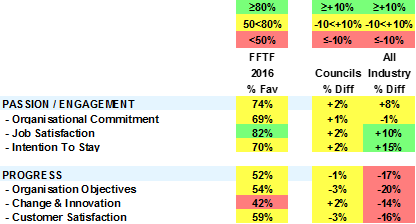Fit for the Future?
Local Government Reform
By Louise Parkes
Voice Project was privileged to participate in the recent Australian Local Government Leadership Summit hosted in Melbourne by the Australian School of Applied Management. It was a timely conference, bringing together
senior leaders from councils across different states and territories, all facing significant challenges from economic, political and reform agendas.
In NSW, councils have of course been undergoing a period of drastic reform, under the banner of Fit for the Future (FFTF). As part of these reforms, the NSW Government has mandated the amalgamation of 44 councils into 19 new merged councils, with a further 9 new council mergers pending court decisions. We have seen mixed reactions to these proposals in the media, with some violent opposition and some seeing opportunities in the $25 million in funding to each new council.
At the conference, leaders of the newly formed Queanbeyan-Palerang Regional Council hosted a panel session to discuss their merger experiences in some depth. Their approach has been considered and comprehensive, with Interim General Manager Peter Tegart sharing the wide-ranging ‘stocktake’ undertaken across the councils to assess organisational capabilities and develop their strategy. One of the tools they used in their assessment was Voice Project’s staff engagement survey – with a twist.
Assessing Transition Readiness
Along with 11 other merging councils, the former Queanbeyan City and Palerang Councils conducted a NSW Local Government Transition Survey, developed and implemented in collaboration between Local Government NSW, Ptok Consulting, and Voice Project. The survey was developed to assist leaders of councils undergoing major reform, including significant transitions such as mergers. It serves to provide a baseline and track employee engagement, assess change capacity and staff attitudes to change.
For the conference, we pulled together the data from these 13 councils, representing 1648 employees, to investigate the trends so far. Specifically, we asked:
What is the general level of understanding, communication of, and support for FFTF reforms?
What is the impact of readiness for the FTFF reforms on staff engagement and their confidence in the council’s future?
What organisational practices support a positive FFTF transition?
Outcomes Measured
The survey included our standard engagement model assessing work practices and two key outcomes of:
Engagement - job satisfaction and enjoyment, commitment to council and willingness to exert extra effort, and intention to stay with council, and
Progress - achievement of council objectives, confidence in a positive future for the council, and delivery of quality services
In addition, the survey included questions around three key aspects of the local government reforms:
Purpose - a shared enthusiasm for, and understanding of the need for change. This included whether staff thought the FFTF reforms: are necessary; will improve the effectiveness of councils; and are part of a strategy with a clear vision
Communication - cut through of key messages to staff, and leaders being open about possible consequences of the changes for the organisation and for individuals. This included whether staff felt they were informed of: the reforms; their potential impact on staff; and any losses that may result from change
Support - a supportive, learning culture, focused on helping and problem-solving, not blaming. Staff were asked if: people were supported to try new approaches, even when they make mistakes; and if there was a culture of helping each other with problems
Typical Council Results
The first thing to point out is that on all our standard metrics, this particular group of councils was no different to our broader Council benchmarks. That is, council staff express high levels of engagement, particularly job satisfaction (10 percentage points above other industries) and intention to stay (15% above other industries). We know that council staff enjoy the variety in their jobs and the ability to contribute in a meaningful way to their communities. On the other hand, they are critical of the current performance of their councils (20% below other industries) and less than half of staff are satisfied with levels of innovation and management of change. This confirms the view expressed at the conference that many councils are indeed in ‘need of a shake’.
FFTF Survey Results
So what about staff perceptions of the FFTF reforms and their impact on key outcomes?
Only 34% of staff believed FFTF reforms are necessary, will improve effectiveness, or are part of a clear broader strategy. However, there was large variability between participating councils, ranging from 18% to 64% supporting the reforms. Staff new to council (less than one year) were much more likely to see reforms as necessary to improve effectiveness (49%).
Most staff (67%) felt informed of reforms generally, but much fewer (44%) felt that potential losses were publicly acknowledged or discussed. The importance of allowing space for grieving over losses such as past council identity and culture was a recurring theme at the conference.
Typically, we find that outdoor staff are less satisfied than indoor staff with a range of council practices. In this case, there was no difference in support for the reforms by indoor and outdoor staff. However, there was substantially less communication getting through to outdoor staff on the changes, and they felt less supported when trying new things and problem-solving. With a 20 percentage point difference in satisfaction it was one of the largest differences between these groups.
When examining the relative impact of these views on key outcomes, belief in the rationale for FFTF reforms actually appeared largely irrelevant to staff engagement and confidence in the future. Regardless of personal support for the reforms, the more important question seemed to be whether their council was in a position to make the most of opportunities afforded – having a “supportive” change culture had the highest impact on outcomes.
Characteristics of FFTF Councils
Unsurprisingly, those councils scoring high on reform readiness also were perceived as:
Learning from mistakes and successes
Having a positive future
Being innovative
Staff in these councils also felt there was good two-way communication between senior leaders and staff, and they had greater confidence in their senior leaders. Their leaders had managed to communicate a positive narrative about the future. This was a timely message at a conference focused on how to build trust as a leader, and sharing best practice on collaborative leadership behaviour.
Fit for the Future Transitions – learnings so far
There is underwhelming staff support for FFTF reform, but it appears to have little impact on morale or confidence. Better to focus resources on how to make the best of the situation council finds itself in
Transparency around reforms does have a moderate impact, but communication is not reaching outdoor staff. More investment needs to made in finding the right channels of communication to connect with outdoor staff. This is critical during transition, but is also likely to have positive impacts beyond the FFTF reforms
Success hinges on building a learning culture focused on problem-solving and support for innovative practice. This is much bigger than the current FFTF reforms, and requires trust in leaders who are collaborative and open to feedback



